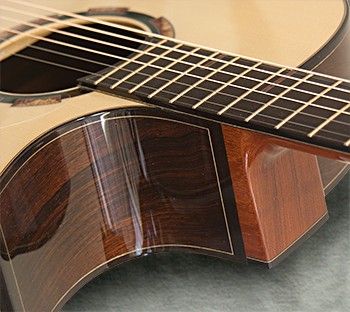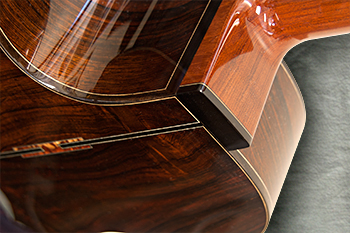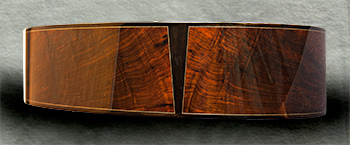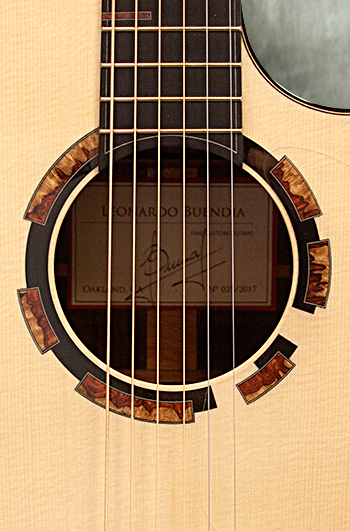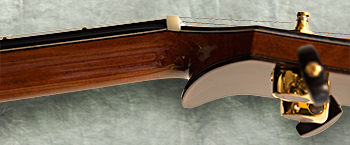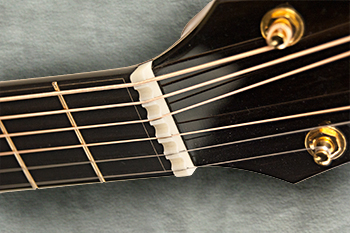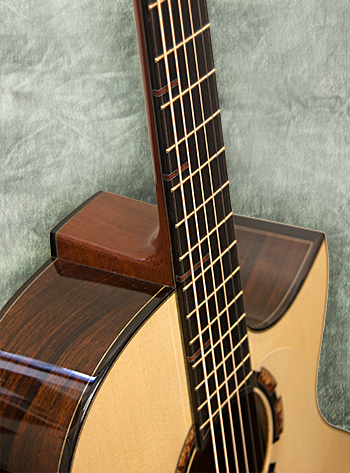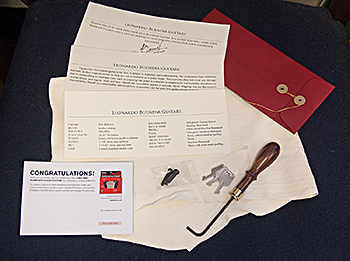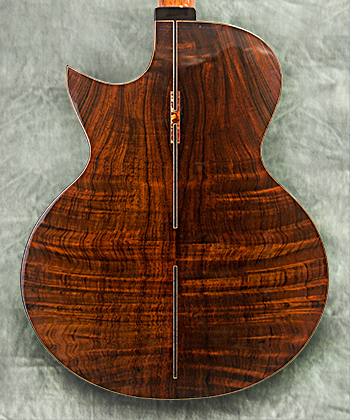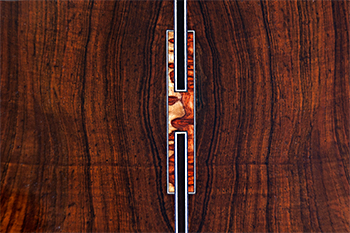2017 Buendia Jumbo
(click on images to see larger versions)
– Buendia jumbo guitar, ser. #25
– top: German spruce (Picea abies)
– back & sides: Brazilian rosewood (Dalbergia nigra)
– laminated inner sides: Peruvian walnut
(Juglans Neotropica)
– neck: 12 frets to the body Honduran mahogany (Swietenia macrophylla) w/ double action adjustable truss rod
– fingerboard: African ebony (Diospyros crassiflora)
– bridge: Brazilian rosewood
– bridgepins: ebony with abalone dots
– front headplate: ebony; amboyna wedge w/black & white purfling, maple underlayer
– body bindings & endgraft: ebony with ebony & maple purfling on top, sides & back
– fingerboard binding: ebony w/ black & white purfling
– heelcap: ebony w/ maple underlayer
– nut: bone
– saddle: bone
– tuners: gold finished Gotoh 510s w/ Grover-style ebony buttons
– bridgeplate: laminated Brazilian rosewood
– rosette: Buendia’s ‘large’ segmented rosette; amboyna blocks w/ black/white/black purfling over ebony segmented ring
– fret markers: integrated side & fingerboard markers of amboyna w/ black & white purfling
– lining: mahogany
– neck & tailblocks: Honduran mahogany
– frets: 18 EVO gold frets
– top braces: Sitka spruce (Picea sitchensis)
– back braces: Honduran mahogany
– glue: mostly Titebond w/ epoxy, cyanoacrylate. Hide glue for fingerboard, bridge & top braces
– finish: nitrocellulose lacquer
– inner box sealant: brushed shellac
DIMENSIONS:
scale length: 25.25″
nut width: 1.75 “
string spacing at saddle: 2.25″
weight: 4.4 lbs.
width, upper bout: 11.5″
depth, upper bout, bass side: 3.5″
depth, upper bout, treble side: 4″
width, lower bout: 16.5″
depth, lower bout, bass side: 3.875″
depth, lower bout, treble side: 4.56″
waist: 9.25″
depth at neckblock: 3.31″ (3 5/16″)
depth at tailblock: 4.56 (4 9/16″)
body length: 20.5″
total length: 40.375″ (40 3/8″)
www.buendiaguitars.com
info@buendiaguitars.com
A Player’s Review, 12/15/18:
The Inspiration
Some years ago, I visited nearby Dream Guitars with my oldest son Andrew www.andrewfinnmagill.com, a professional violinist who also plays several other instruments, including guitar (he’s a better guitarist than I am). Dream’s owner Paul Heumiller was installing a pickup in one of my instruments, and while we waited, Andrew and I wandered through the shop playing guitars. As Paul was finishing up, I asked him if his personal Ervin Somogyi guitar was around. It’s this one and believe me when I say that the clip really doesn’t do it justice.
Paul had been raving about this guitar and I was curious to hear it for myself. He brought it out and while he and I were finishing up our business, Andrew took it out of its case and strummed a chord. Immediately, my head whipped around to see the guitar that had made that Sound. He’d only played a single chord, and while it was still ringing, Andrew looked at me and said, without hesitation, “This is the best guitar I have ever played.” I agreed with him. He played for a bit longer, exploring the fingerboard, then we had to leave. The sound was breathtaking, magnificent. It’s a voice I named the ‘Huge & Exquisite.’ The next day, Paul was hosting a house concert, and I decided to come out a bit early to have a chance to play the Somogyi, but as I thought about it during the day, I changed my mind. Once before, I had played a guitar I could not afford, and its voice haunted me for more than 20 years (see my review of this Circa 00). I wasn’t ready to have that happen again, but the damage was already done and the Huge & Exquisite was already stuck in my head.
Since that day I’ve played several other Somogyi guitars as well as those by several of Ervin’s apprentices: Kostal, Matsuda, Kraut, Sands, Ebata, Beauregard etc. Each builder has staked out his own distinctive tonal ‘territory,’ but each is also unmistakably in the Somogyi lineage. As I pined for the Huge & Exquisite, my friends Paul Heumiller and Al Petteway, who know what I like and whose opinions I trust, told me that the guitars they had played by Somogyi’s recent apprentice, Leonardo Buendia, had the sound I was looking for. Leo was still early in his career as an independent luthier so his prices were within my reach (barely), so I placed my order with Dream Guitars. Paul must have liked its specs, because soon afterwards, he decided to order this Buendia Jumbo for himself(!).
This guitar was delivered just before St. Patrick’s Day in 2017 and you can find the Acoustic Guitar Forum build thread for it here. You can see the Dream Guitars webpage for this guitar and hear a video clip of Al Petteway putting it through its paces here. Like all clips, it’s only an approximation of what it sounds like in person, and the guitar was brand-new when the clip was recorded. It sounds very different now as you can read about below. One caveat about the pix: Dream’s photos boost the saturation to enhance the grain in the Brazilian, so it looks a bit brighter and redder than it actually is. The photos on these pages show the color more accurately.
For most of the new instruments I review, I wait a few months to let it adjust to life as an instrument, as well as give myself time to really get to know it. I have owned this guitar for over a year and a half, and as you will see in my evaluations below, it is only now that I feel familiar enough with its distinctive voice to offer a review of it.
The Design
I had told Leo I wanted his version of the Huge & Exquisite. I was fortunate in that Leo had been taught by Ervin how to achieve that sound, and the Dream Guitars webpage for Paul’s special Somogyi featured detailed descriptions, photos and a video clip to which Leo could refer, so my usual conversation with a new luthier to agree on the meaning of the terms we’d be using wasn’t required. Hitting the target Sound has always been the main objective in all of my builds, and all other specs are chosen in service to that goal. Accordingly, I willingly let myself be guided by Leo in most of the decisions required. For reasons decribed below, we agreed on a jumbo body, Brazilian rosewood back & sides, German spruce top, a 12-fret neck and a Brazilian rosewood bridge. My ergonomic decisions were for a Manzer wedge, my preferred rounded-V neck profile, fretmarkers and a cutaway, while my cosmetic decisions determined the rosette and backstrip. I selected an asymmetrical headstock profile Leo had used before, a bit shorter and wider than his current style because I thought it provided a better visual balance with the jumbo body. I chose a Hoffee case in dark red with gold interior to complement the dark red and cream color of the amboyna burl. One nice bit of synchronicity: I had placed this order as my own celebration of the 25th Anniversary of the program I developed and direct, The Swannanoa Gathering Folk Arts Workshops, and when the guitar arrived I found that it was serial number…. 25.
Playing an instrument is a complex sensory experience involving Sight, Sound and Touch, and here are my thoughts regarding each of these dimensions for this guitar.
SIGHT
As might be expected from a ‘Somogyi-school’ builder, Leo’s joinery, fit & finish, eye for design and overall craftsmanship are world-class and impeccable. There is nothing to find fault with in the materials, concept or execution of this instrument. The German spruce is beautifully even in grain count and color over its whole surface, especially notable in a jumbo-sized top. The Brazilian back I chose, figured in the wavy pattern that recalls a horse’s tail, is repeated in the grain of the sides where they come together near the end graft. Amboyna burl was selected for the segmented rosette, backstrip, fretmarkers and Leo’s signature headstock wedge. I typically prefer bound headstocks, but Leo’s design provides something of an alternative. In the headstock closeup above one can see that Leo has added veneers of white and black under the headplate. He then bevels the edges of the headplate which slightly expose the white veneer except when viewed exactly face-on, providing a subtle border of white wood. The mahogany neck is adjustable through the soundhole at the neck block so the headplate design is not cluttered with a trussrod cover. The gold Gotoh 510 tuners are complemented by the gold EVO frets, but I replaced the tuners’ original black plastic ‘alien-head’ buttons with the ebony Grover-style buttons I prefer. The nut is cosmetically scalloped between the strings and the 1/4″ thick saddle features chamfered string slots with each string individually compensated. The headplate, backplate, fingerboard, heelcap, end wedge and body binding are ebony with a white wood (holly, maple?) purfling on top, back, sides, all edges of the fingerboard and all of the amboyna accents.
Some other notable features of Leo’s guitars include a sealer (varnish? shellac?) on the inside of the back & sides to keep out moisture, bridge pins that are incised with white notches to indicate which strings they secure along with two extra pins, a handsome wooden-handled adjustment wrench, a heavy resealable red envelope containing a specifications list for the instrument, the warranty card and a personal thank you, signed by Leo. There was also a card, redeemable for a D’Addario guitar humidification system, three keys for the case and a chamois polishing cloth. All very classy touches worthy of the guitar itself.
TOUCH
Most of this category addresses how it feels to play it, but there are some basic tactile impressions as well. I had told Leo I liked light guitars, but I was expecting a jumbo size to be a bit on the heavy side, so when it weighed in at only 4.4 pounds, the same as my OM, I was impressed and pleasantly surprised. The guitar’s balance point is almost exactly at the widest part of the upper bout – nearly perfect. Before I placed my order, I had tried out a few jumbo guitars for feel and decided to go with a Manzer wedge that tapers the body to a shallower depth on the bass side and makes it feel like playing a smaller guitar. It works beautifully on this guitar; it doesn’t feel that much bigger than my OM. In fact, the depth of my OM is 3/16″ greater at the upper bout’s bass side than the Buendia. I frequently fret the 6th string with my left thumb, so it’s important to me for the neck to remain reasonably slim, even up around the 9th fret. Accordingly, Leo duplicated the rounded-V neck profile of my other guitars, so all the necks feel interchangeable. The Florentine cutaway provides easy access all the way to the 16th fret, especially important to me on a guitar with a 12-frets-to-the-body neck. The Buendia also features a wide, flat neck heel that looked less substantial to me than the Martin-style pointed heel I’m used to, but now that I’ve played on it a while I love the flat heel; it really helps with access to the upper frets.
The necks on all my guitars, including the Buendia, are finished with either nitrocellulose or UV polyester, and on each one I find that the finish tends to lightly grip my palm and fingers, creating a slight, but audible squeaking when I change chord positions. Thinking it might be the high gloss that was the problem, I tried some baby powder on my hand without success. Then I took a micromesh cloth to the neck of my UV polyester Bashkin to knock some of the gloss off. The squeaking was diminished but not eliminated, so it must be that my skin and guitar finishes are a just bit grippy. The only necks I’ve tried that don’t have this issue are those of vintage guitars with decades of playwear and mandolins that have had a ‘speed neck’ treatment that takes the finish down to the wood with just a light sealer coat like that on a violin’s neck. I have a build coming in 2019 with a french polish finish and maybe that will help…
The amboyna accents at frets 5, 7, 9, 12 & 15 that serve as integrated side-and-fretboard markers have darkened a bit and are not as easy to see as initially. If I had it to do over, I would ask Leo to use more of the cream-colored sections of amboyna for the fretmarkers to make them a bit more visible in low light. The action is set up low for fingerstyle, but a 64th of an inch higher at the 12th fret than my exclusively fingerstyle guitars to allow for occasional strumming when played with moderate force. I usually play with a lighter touch, but it’s always good to have a bit of headroom. For whatever the reason, some guitars feel ‘stiffer’ to play than others with identical fret scales, action and strings. My Collings OM played very stiff, while my Bashkin is nearly effortless. The Buendia is somewhere in the middle, but more toward the Bashkin end of the spectrum. The fret ends are smooth and comfortable, and EVO is a great compromise in durability and tone between frets of softer nickel silver and harder stainless steel. The top also features a clear plastic pickguard that protects it from errant pick strokes while remaining essentially invisible.
SOUND
It’s a pleasure, but a bit intimidating to write about such a distinctive guitar, which is why I wanted to spend a good bit of time with it and really get to know it thoroughly before making the attempt, because not only is it unlike any other guitar I’ve ever owned, it’s unlike most of the guitars I’ve ever played. It has a number of special features, all chosen in pursuit of that Huge & Exquisite voice which has lows that are massive, mids that are strong and punchy, highs that sparkle, and a smooth, blended tone that retains good note separation.
For the past 15 years or more I’ve played nothing bigger than an OM, but to insure those Huge & Exquisite lows & mids I chose a jumbo body, my first guitar of that size. Leo suggested Brazilian rosewood as the best way of getting our target sound. I’ve owned guitars made with East Indian, Madagascar and Panamanian rosewood, but this is my first Brazilian guitar. Leo also pointed out that the Somogyi that I liked so much featured a 12-fret neck, which imparts a special tone. Not only does it move the bridge position lower, into the center ‘sweet spot’ of the top’s vibrating diaphragm, it also uncouples the bridge from the braces underneath it, producing a voice that is less powerful than a 14-fret neck, but with a tone of unsurpassed sweetness. Leo also believed that a rosewood bridge would have a higher resonance or ‘Q’ factor, and be less damping than ebony. All these features were included in the guitar’s final specs.
Alpine spruce is a popular choice for fingerstyle so a fine German top was chosen. Several luthiers who have seen this guitar have commented on the thinness of the top, which makes for a very lively and resonant soundboard. Inside, the top was fitted with cleats along the center seam to add strength and stability, and now, after a year and a half, as the lacquer finish has continued to cure and shrink down into the grain, some sections of the bracing pattern are visible as a slight irregularity in the finish when light reflects off it at just the right angle.
‘Somogyi-school’ guitars just sound different, and my usual standards for evaluating a guitar’s sound required some adjustment. For example, the first time I put a pick to it after taking it out of the case, I thought its powerful lows & mids were everything a guitar should be, but that the tone of the trebles lacked something I couldn’t put my finger on. I tested the trebles repeatedly in chords and single strings, and found that they weren’t lacking in balance or volume, but tonally I was simply expecting a bit more sizzle in the trebles, like that of the smaller, shallower guitars I was used to. And that was really the issue. After some extensive playing time, I concluded that I was unused to a such a big-bodied guitar with this much depth and the volume of air it pushed out, and that it was unrealistic to expect trebles like those of a smaller, shallower guitar playing the way I always had. Just as boosting the bass on the tone control of an amplifier makes the entire dynamic range bassier, not just the lows, similarly, a jumbo body will give not only a deep bass, but deep mids and trebles also. As it turned out, the nut and saddle materials were a factor as well (see Updates below).
Experience told me that being new, the tone would continue to smooth out and sweeten over the months of playing, and so it did… but as I experimented with different strings & picks I had a revelation. My usual flatpick is a BlueChip TP 40, which adds a warmer and slightly darker tone to my OM and 00-sized guitars. The jumbo hardly needs more of this quality, so when I went with a bit thinner pick, a TP 35, Voila! It added enough of the brightness I was missing.
In addition, much of my playing is fingerstyle, using plastic picks on the thumb and three fingers. The picking motion of the thumb pushes down, across the bass-side strings, producing a meaty, thick tone. But the picking motion of the fingers is lighter, brushing upward on the treble-side strings, producing a tone with a bit more crispness in the strings which usually carry the melody. This also helps balance the voice tonally. Like many of the things about the Buendia, I just needed to listen with a different set of ears…
What follows are my evaluations of the various parameters in this instrument’s voice.
Balance.
Balance refers to the relative volume and presence of each string. This is a critical quality for me. If a guitar is not well-balanced, it won’t keep my interest. As mentioned above, this guitar’s balance is excellent (no scooped mids here!), and all parts of the dynamic range are extremely articulate, with outstanding note separation. The bass is rattle-your-backbone deep, but still articulate and not muddy. The midrange is assertive, forceful, and the trebles are clear, balanced and dry.
Sustain.
I measure sustain by using a stopwatch, hitting a firm strum, then leaning in close until the sound fades to silence. I do this 4 or 5 times, then average the results. I’m usually within a second each time. My 1980 Sobell cittern is my benchmark instrument for a long sustain at a ridiculous 42 seconds. Too little sustain will sound ‘tubby’ and unsuitable for fingerstyle’s long, ringing tones, and too much will make it sound ‘jangly’ and unsuitable for percussive strummed accompaniment. I’ve found sustain’s sweet spot for my style of playing to be plus-or-minus 30 seconds. This guitar sustains for right at 31 seconds, which is excellent for my purposes.
Volume & Projection.
This is a measure of the amplitude for both player (volume) and listener (projection). While not the loudest guitar I’ve ever owned, the Buendia has a very big voice with excellent volume and projection that envelops both the player and listener and makes it easy to get lost in.
Response.
This quality describes both the amount of energy required to move the strings (its sensitivity) as well as the speed at which it responds to that energy. A quick response is said to be ‘punchy’ while a slower response is said to ‘bloom.’ An instrument with strong punch will tend to have a shorter sustain, since much of the energy moving the string is expended immediately after the pick’s attack, while a guitar that blooms tends toward a longer sustain. The Buendia has strong punch, especially prominent in the lows and mids, and yet also blooms and sustains very well. There is a thickness, a substantial muscularity to each string. Every note is propelled from the instrument with strength, while retaining warmth. Remarkably, the punchiness is there even when it is played with a light touch.
Depth.
The depth or spaciousness of the sound is what gives it dimension and presence. I think of it as how far down in the guitar the sound seems to come from and how much air is behind that sound. As one might expect, the Buendia’s depth is huge. Like the tip of an iceberg, what one hears only hints at the massiveness supporting it.
Presence.
Presence describes how much space the sound seems to occupy between the instrument and the listener. If it radiates out in a cone from the sound source, how wide does that cone seem to be? Is it more spacious or less spacious? Does it sound relatively narrow and directional, or wider and more enveloping? The Buendia has excellent presence that is currently fairly wide and more forward-focused, but I expect it to expand with continued playing.
Resonance.
The number and character of harmonic frequencies detectable in the sound is what many call resonance. However, I make a distinction for it here as a measure of fullness in the sound I can both hear AND feel. This guitar’s resonance is outstanding, and as light as it is, it produces sound at the slightest touch, and when held close, and leaning over it while playing, the feel of it vibrating through my chest and under my hands, enveloped by the sound, makes me feel like a part of the guitar.
Overtones.
Overtones are the harmonic frequencies complementing the fundamental tones. Some limit the definition to partials of the plucked strings, but I use it to encompass sympathetic vibrations in the unplucked strings as well. As luthier Alan Carruth puts it, “An acoustic guitar acts as a complex filter, reducing the output of some frequencies and enhancing others relative to the mix the plucked string produces. Every guitar is a bit different in this regard.” Initially, this guitar’s overtones were a moderate collection of individual frequencies, but recently, they have mellowed to become more complex in number and more blended in quality, producing a good concentration of pleasing tones.
Timbre/Tone.
Tone Is Everything for me. Like all things rare and precious, it’s the constant, restless search for the next Exceptional guitar tone that can make my ears melt in ecstasy, and the excitement of discovery when I hear it, that drives my Quest. If the sustain and overtones give an instrument its distinctive ‘personality,’ timbre or tone describes the quality of that personality, combining the fundamentals, overtones and all other resonant frequencies generated by both the vibrating strings and the vibrating wood to create a particular instrument’s unique voice. It’s what makes a middle ‘C’ played on a clarinet sound different from a middle ‘C’ played on a trumpet, and what makes ‘this’ guitar sound different from ‘that’ guitar. It is this ‘quality of personality’ I believe most folks refer to when they speak generally about an instrument’s Tone, and this is a subjective area where metaphor becomes the standard currency. While not presuming to impose my own language on others, I offer here my own definitions of a few commonly used metaphors that I have found useful. To my ears, many of these terms refer to points on a spectrum of a given quality. For example:
- ‘warm/dark’ to ‘less warm/bright’ – A warm, dark tone has a soft, mellifluous quality, while bright instruments have more edge and brilliance. Timbre or tone is a quality of the entire dynamic range of the instrument, so an instrument with a bright timbre will have a crispness throughout, even in the low end, while a warm, dark-toned instrument will have a softer edge to the sound, even in the high end.
- ‘dry’ to ‘complex’ – Fewer overtones on the dry end to more on the complex end. I sometimes refer to overtone complexity as ‘shimmer’ or ‘sparkle,’ to describe the interaction of overtones blending with the fundamental.
- ‘thin’ to ‘fat’ – A measure of robustness having less resonance on the thin end to an abundance of resonance on the fat end. How ‘thick’ a note sounds is often a consequence of its ‘punch,’ or the speed of its response to the pick’s attack. My mandolin buddy Mike Marshall describes instruments with punchy, fat tone as having ‘good bone structure,’ or an underlying solidity to the notes.
The Buendia is a warm but articulate guitar, dominated by an intoxicating sweetness that tends to forgive any perceived faults, and as that sweetness continues to develop, it continues to fascinate as well. While somewhat dry-sounding when new, over the months of playing, the underlying complexity of its tone has become more prominent with the development of more shimmer which, to my ear, is always the crowning touch to Exceptional tone, adding brilliance and articulation to enrich its natural warmth. The Buendia is such a responsive instrument that its fundamental punchiness is complemented by considerable bloom after the attack as well, resulting in a thick, fat Tone that rings out with sustained power everywhere on the fingerboard.
SUMMARY
Everything in this guitar’s remarkable voice was present from the first time I played it – just in different proportions or stages of refinement. Back then, its tone was vibrant but immature, and only hinting at its great potential. Now, with a bit of age and lots of playing, it’s just beginning to come into its true voice, with more interest and complexity in the tone. I prefer a voice that doesn’t reveal itself all at once, but always seems to hint at deeper, hidden levels still to be explored. That’s the tone that keeps me reaching for a guitar, and specifically this guitar, just to hear what it will reveal next.
The Buendia has become richer over time, with more prominent overtones and greater refinement in general… and it’s still just in the early days of its development as an instrument. It sounds smoother and more sophisticated, with a concentration of its strengths into a tone that is greater than the sum of its parts, which, as it turns out, is one of Leo’s specific objectives.
In an interview published not long after this review was written, in response to guitarist Michael Watts’ question about the timbre he was striving for, Leo said, “When I go and see a concert the most important aspect of the show is the sound engineer. The band could be spectacular, but without a good sound engineer it could be the worst musical experience of your life. I want my guitars to sound like a full band. I don’t want there to be too much ‘bass,’ too much ‘drums,’ or too much ‘vocals’ or ‘violin.’ I want my guitars to sound like a full band in harmony… balanced and ‘as one’ across the whole timbral range.”
The voice of this guitar has a bass that is deep, mysterious and powerful, with muscular, vibrant mids, and clear, ringing trebles. This is what I asked Leo for, and to my delight, amazement and eternal gratitude… it’s what he delivered.
Many use the development of fine wine over time as a metaphor for Tone, but I’m a single malt guy. If I’m in the mood for a straightforward, uncomplicated dram I’ll reach for my always-satisfying 10-year old Laphraoig, which is like a sonata for the palate, but if I’m in the mood for something more extravagant and symphonic, only my special bottle of 30-year old can provide the richness and complexity I crave… and that’s the Buendia.
So, in my quest for guitars I would consider ‘Exceptional,’ the best of the best, does this one qualify? Unquestionably, and I count myself as extremely fortunate to be its steward. I eagerly look forward to helping develop its extraordinary Voice.
One day, I decided I would try to come up with a ‘3-Word Review’ for each of my guitars; three descriptive terms that would sum up each instrument’s strongest qualities. For my Bashkin 00, they were ‘Warm, Sweet, Intimate.’ For my Circa OM they were ‘Regal, Assertive, Complex.’ For the Buendia, ‘Imperial, Singular, Revelatory’ will do… for a start.
UPDATE 6/2/19:
Recently, Paul Heumiller’s game-changing Huge & Exquisite Somogyi came back through the Dream Guitars shop, and this time, having lived with my Buendia awhile, I was eager to try it out. Here‘s a clip of what it sounds like today. It was still the extraordinary guitar I remembered, but I was surprised and beyond pleased to find that I preferred Leo’s sound. Paul and Al had been right.
UPDATE 12/10/19:
In a quest to add a bit more sparkle to a very dark-toned guitar, I recently replaced Leo’s standard bone nut and saddle with those made from the hardest organic material available, West African Hard Ivory (WAHI), harvested legally from the small forest elephants found in west Africa. WAHI is hard to find and costly, but fortunately Leo was able to provide nut & saddle blanks, and the work was done by Ken Jones of Mountain Song Guitars. I had done this upgrade before with my Circa OM and Bashkin 00, and liked the result, and the experiment also proved successful with the Buendia. It now has a bit more crispness and articulation throughout its dynamic range and perhaps a bit more volume as well. All organic materials have variation, and it could be that the original bone nut and saddle were less hard than they could have been. At any rate, I now feel that the brightness end of the Buendia’s tonal spectrum has been maximized.
UPDATE 2/2/20:
Having lived with the WAHI nut & saddle for nearly two months, I can’t get over how such a small, but noticeable change can so profoundly affect my satisfaction with an instrument. The cost of the materials and labor were significant, so this was a bit of an expensive gamble, but I’d had good results before and so I took a chance. The resulting tone has just enough additional sparkle and volume to captivate me anew and make me linger with it, enjoying and rediscovering its voice. It doesn’t sound like a different guitar, just a better, more interesting version of itself. It’s the voice it was meant to have. I’ve fallen in love with its tone all over again, and feel like the upgrade was unquestionably worth it.




